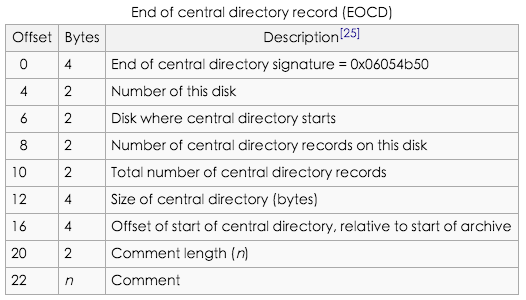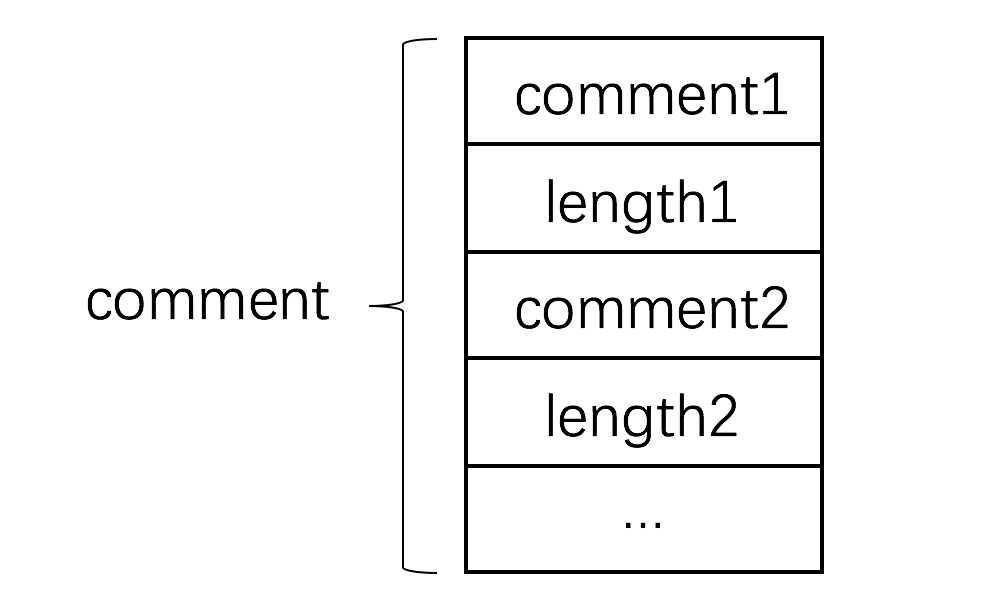背景
我们在日常使用应用可能会遇到以下场景。 场景1: 用户浏览h5页面时看到一个页面,下载安装app后启动会来到首页而不是用户之前浏览的页面,造成使用场景的割裂。
场景2: 用户通过二维码把一个页面分享出去,没有装猫客的用户如果直接安装启动之后无法回到分享的页面。
如果用户在当前页面下载了应用,安装之后直接跳转到刚才浏览的界面,不仅可以将这一部分流量引回客户端,还可以让用户获得完整的用户体验。下面提出一种方案来满足这个业务需求。
原理
android使用的apk包的压缩方式是zip,与zip有相同的文件结构,在zip的Central directory file header中包含一个File comment区域,可以存放一些数据。File comment是zip文件如果可以正确的修改这个部分,就可以在不破坏压缩包、不用重新打包的的前提下快速的给apk文件写入自己想要的数据。
comment是在Central
directory file header末尾储存的,可以将数据直接写在这里,下表是header末尾的结构。 
由于数据是不确定的,我们无法知道comment的长度,从表中可以看到zip定义comment的长度的位置在comment之前,所以无法从zip中直接获取comment的长度。这里我们需要自定义comment的长度,在自定义comment内容的后面添加一个区域储存comment的长度,结构如下图。
 这里可以将一个固定的结构写在comment中,然后根据自定义的长度分区获取每个部分的内容,还可以添加其它数据,如校验码、版本等。
这里可以将一个固定的结构写在comment中,然后根据自定义的长度分区获取每个部分的内容,还可以添加其它数据,如校验码、版本等。
实现
这一部分可以在本地进行,需要定义一个长度为2的byte[]来储存comment的长度,直接使用Java的api就可以把comment和comment的长度写到apk的末尾,代码如下。
public static void writeApk(File file, String comment) {
ZipFile zipFile = null;
ByteArrayOutputStream outputStream = null;
RandomAccessFile accessFile = null;
try {
zipFile = new ZipFile(file);
String zipComment = zipFile.getComment();
if (zipComment != null) {
return;
}
byte[] byteComment = comment.getBytes();
outputStream = new ByteArrayOutputStream();
outputStream.write(byteComment);
outputStream.write(short2Stream((short) byteComment.length));
byte[] data = outputStream.toByteArray();
accessFile = new RandomAccessFile(file, "rw");
accessFile.seek(file.length() - 2);
accessFile.write(short2Stream((short) data.length));
accessFile.write(data);
} catch (IOException e) {
e.printStackTrace();
} finally {
try {
if (zipFile != null) {
zipFile.close();
}
if (outputStream != null) {
outputStream.close();
}
if (accessFile != null) {
accessFile.close();
}
} catch (Exception e) {
}
}
}
首先获取apk的路径,通过context中的getPackageCodePath()方法就可以获取,代码如下。
public static String getPackagePath(Context context) {
if (context != null) {
return context.getPackageCodePath();
}
return null;
}
获取路径之后就可以读取comment的内容了,这里不能直接使用ZipFile中的getComment()方法直接获取comment,因为这个方法是Java7中的方法,在android4.4之前是不支持Java7的,所以我们需要自己去读取apk文件中的comment。首先根据之前自定义的结构,先读取写在最后的comment的长度,根据这个长度,才可以获取真正comment的内容,代码如下。
public static String readApk(File file) {
byte[] bytes = null;
try {
RandomAccessFile accessFile = new RandomAccessFile(file, "r");
long index = accessFile.length();
bytes = new byte[2];
index = index - bytes.length;
accessFile.seek(index);
accessFile.readFully(bytes);
int contentLength = stream2Short(bytes, 0);
bytes = new byte[contentLength];
index = index - bytes.length;
accessFile.seek(index);
accessFile.readFully(bytes);
return new String(bytes, "utf-8");
} catch (FileNotFoundException e) {
e.printStackTrace();
} catch (IOException e) {
e.printStackTrace();
}
return null;
}
这里的stream2Short()和short2Stream()参考了MultiChannelPackageTool中的方法。
测试
在生成apk后,调用下面的代码写入我们想要的数据,
File file = new File("/Users/zhaolin/app-debug.apk");
writeApk(file, "test comment");
安装这个apk之后运行,让comment显示在屏幕上,运行结果如下。 
运行结果符合预期,安装包也没有被破坏,可以正常安装。
结论
- 通过修改comment将数据传递给APP的方案是可行的,由于是修改apk自有的数据,并不会对apk造成破坏,修改后可以正常安装。
- 这种方案不用重新打包apk,并且在服务端只是写文件的操作,效率很高,可以适用于动态生成apk的场景。
- 可以通过这个方案进行h5到APP的引流,用户操作不会产生割裂感,保证用户体验的统一。